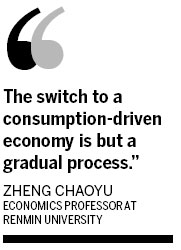

Local governments in China are still relying on increasing investment during the current half to meet their 2013 GDP growth targets, despite the central government's call for a change in direction from investment to innovation and consumption.
Thirteen provincial-level regions - more than one-third of the total of 31 on the Chinese mainland - reported that GDP growth in the first three quarters was below their full-year targets.
The shortfalls prompted a surge in local investment that experts warn may exacerbate the local debt burden and immerse the country again in the consequences of excessive investment.
Provinces that have announced massive investment plans include Sichuan at 4.26 trillion yuan (about $700 billion) over the next two years, Fujian at 3.95 trillion yuan, Guizhou at 1.7 trillion yuan and Guangxi Zhuang autonomous rgion at 1.5 trillion yuan.
|
Workers build a bridge at a construction site Linzhou, Henan province. Thirteen provincial-level regions reported that GDP growth in the first three quarters was below their full-year targets. Provided to China Daily |
The Sichuan plan is the largest package of local investment in recent years. It even exceeds the 4 trillion yuan national stimulus package launched by the central government in 2008 to ease the impact of the global financial crisis and subsequent economic downturn.
A lot of this round of spending has to do with the nation's western development strategy.
The Chengdu-Chongqing Economic Zone, which involves the capital of Sichuan province and the municipality of Chongqing, is high on the list of projects requiring investment.
That zone will need major traffic improvements, including a new airport in Chengdu and inter-city superhighways.
Local government bonds will constitute a major part of the funding. Sichuan has the largest outstanding stock of local government bonds in China, with issues of 20 billion yuan in 2012 alone, directed mainly to infrastructure.
Tang Limin, head of the Sichuan development and reform commission, expressed optimism about funding.

Fixed-asset investment in the province stood at nearly 1.2 trillion yuan in the first seven months of the year, slightly less than the 1.3 trillion yuan earmarked for investment, said Tang.
"The switch to a consumption-driven economy is but a gradual process," said Zheng Chaoyu, economics professor at Renmin University, "Investment will continue to play a significant role in economic growth.
"China's urbanization and industrialization will be sustained by large-scale investment," Zheng added.
"Investment and consumption are not mutually exclusive. The rise in investment does not come at the expense of consumption. Moreover, individuals' purchasing power is not strong enough to sustain the current rate of economic growth."
National GDP grew by 7.7 percent year-on-year in the first three quarters of the year, according to the National Bureau of Statistics. The real disposable income of urban residents, in comparison, rose 6.8 percent.
Zheng warned that the government-driven investment signals the economy is still recovering from the financial crisis, as private investment is too low to generate any meaningful stimulus.
As a last resort, the government is taking the lead in investment, amid pervasive pessimism in the market.